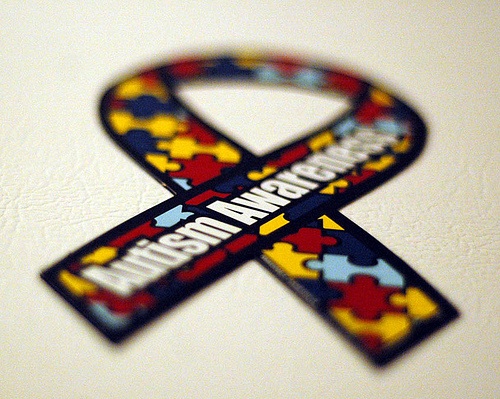I hadn’t planned on blogging about GAPS until I actually started the diet myself, but I was so stirred and encouraged by a recent article from Dr. Mercola that I feel compelled to begin sharing my thoughts on this subject which I feel so passionately about. If you’re not already familiar, Dr. Mercola is a world-renowned holistic physician who publishes an online health newsletter, and is highly respected and well-known throughout the natural health community. In the article, Dr. Mercola posted an interview with Dr. Natasha Campbell-McBride, neurosurgeon, nutritionist, and author of the revolutionary book detailing the link between digestive health and neurological, psychological, and other disorders, Gut and Psychology Syndrome, regarding how the specific diet which she has created and details in her book completely reversed her child’s autism. And believe me, her son’s GAPS success story, is one of many.
As a former ABA specialist, the subject of autism treatment is one which is close to my heart. I have worked among dozens, probably close to hundreds, of children and adolescents affected by ASD (Autism Spectrum Disorders) and other Pervasive Developmental Disorders over the course of the last six years or so, in various positions I have held in the field of social work and behavioral therapy.
I stopped working with ASD children as a behavioral interventionist, because I no longer believe that’s the right answer to autism. At least, it should certainly not be the primary focus, in my opinion.
The Missing Piece
When I became aware of the healing that real food brings, I was immediately spurred to change my career path and work toward becoming a nutritional therapist. I wanted to master the ways in which I could actually treat autism, not autistic behaviors. It began to drive me absolutely crazy to see parents I worked with unknowingly poisoning their children with fake food, literally leaving their bodies starving for nutrition, and allowing their health to deteriorate from the inside.
All the energy I was devoting to help these families with children struggling with this disorder started to feel for naught — due to the restrictions of working for an agency, I wasn’t allowed to dispense any of the advice they really needed to hear. I could only show them, “here’s how we handle your child’s tantrum,” not “here’s how we can start actually decreasing these problems by healing what’s causing them.”
Managing the behavioral and functional symptoms of autism through techniques like ABA without recognizing or addressing the cause of the disorder, is like putting a band-aid on a gaping wound in need of stitches. Sure, it will help you manage, but it’s not fixing the problem. And the longer you wait to get those stitches, the worse off you’re gonna be.
This, to me, is very much in line with the way conventional medicine tends to simply throw out “a pill for every ill” rather than healing the source of the sickness. But the biggest problem facing the ASD community today is the lack of awareness that there is indeed a known source — autism is truly not the “mystery” that many would have you believe.
When I have learned from Dr. Campbell-McBride and others, is that despite what nearly every doctor or “expert” on the subject will tell you, autism is reversible. How?
It’s in your gut
Autism is a digestive disorder. The gut, or digestive system, in patients with autism, is damaged and not able to function properly to digest foods and absorb nutrients. Instead, the damaged gut allows toxins such as pathogenic bacteria to enter the bloodstream and harm the neurological functions of the body. This damage occurs as a result of having an imbalance of intestinal flora, or bacteria. Dr. Campbell-McBride explains (transcript quote taken from Dr. Mercola’s article):
“What happens in these children [is that] they do not develop normal gut flora from birth…” she says. “Gut flora is a hugely important part of our human physiology. Recently research in Scandinavia has demonstrated that 90 percent of all cells and all genetic material in a human body is our own gut flora. We are just a shell… a habitat for this mass of microbes inside us. We ignore them at our own peril.
…As a result, their digestive system—instead of being a source of nourishment for these children—becomes a major source of toxicity. These pathogenic microbes inside their digestive tract damage the integrity of the gut wall. So all sort of toxins and microbes flood into the bloodstream of the child, and get into the brain of the child. That usually happens in the second year of life in children who were breast fed because breastfeeding provides a protection against this abnormal gut flora. In children who were not breastfed, I see the symptoms of autism developing in the first year of life. So breastfeeding is crucial to protect these children.”
The toxicity that forms as a result of an unhealthy gut, clouds the brain’s sensory functions and ability to decipher and process sensory information during a very critical time in the child’s development. This leads to an inability to foster communication and other instinctive functional skills due to the the massive “clogging-up” of brain activity with an overload of toxins.
An unhealthy gut essentially leads to an unhealthy child who is not able to tolerate further toxic influx such as from vaccine damage or other environmental stress to the body’s systems.
These problems are only exacerbated by the typical American diet — processed foods, sugars, and grains feed pathogenic bacteria in the gut, only furthering its dominance and damage to the gut, while inhibiting healthy flora from thriving.
A puzzle solved
Healing with the GAPS protocol comes from three main sources:
- Diet: The GAPS diet starts your digestive system back at square one. It gives the patient only the easiest foods to digest so that the body can focus on healing the damage within the gut, rather than trying to process difficult-to-digest foods. Slowly, more and more foods are introduced, but only foods chosen to specifically nourish the healing process are allowed. Healthy fats, ferments, and very nutrient-dense foods are the cornerstones of the GAPS diet.
- Supplementation: The use of therapeutic-grade probiotics are essential in repopulating the gut with beneficial bacteria and restoring healthy intestinal flora. Vitamins A and D are also critical for the GAPS patient — these can be provided in a highly-absorbable form of cod liver oil. Sun exposure to trigger the body’s own production of vitamin D is also important.
- Detoxification: Natural and gentle detox methods such as epsom salt baths, and vegetable juicing can give a highly beneficial boost to the detoxifying effects of a healing diet such as GAPS. It’s crucial that the body rids itself of as many neurologically-damaging toxins as it can during this the healing process.
Dr. Natasha explains in the interview that the GAPS protocol needs to be implemented as soon as possible for maximum healing to take place. I now believe that behavioral therapies such as ABA can be a good tool to use while you work on healing the child through diet and nutrition, but first and foremost, children with ASD desperately need nutritional intervention, such as with GAPS, before all others.
The interview video below is absolutely packed with a wealth of information from Dr. Campbell-McBride about how she heals her patients who have autism, with GAPS. It’s fairly long, but I think you’ll find it as fascinating as I did if you hit play and keep an ear on it for the next hour or so.
http://www.youtube.com/watch?feature=player_embedded&v=GjJhh47Emao
As I mentioned earlier, I do plan on starting the GAPS diet myself — but I don’t have autism. GAPS can be used to heal a myriad of health conditions — but I think I’ll save getting into the details on that for another day. I’m really looking forward to the healing I know the GAPS diet will bring for me, and spreading the very important message that there is hope for everyone who suffers from health issues related to the gut.
Do you know a child with autism who could benefit from the GAPS nutritional protocol? I encourage you to share this information, and especially Dr. Mercola’s interview with Dr. Natasha, with any families you know who could benefit from it!





Our entire family (except Annica) is gluten-free and has been for nearly 4 years. Some of us are also casein-free. Eliminating gluten and casein from Sara’s diet has healed her eczema. By the way, I was treated to lunch by your beautiful mother today. We talked about you. 🙂
Yep, I’ve worked in the same field. Having one’s professional hands tied that way is an awful feeling, isn’t it?
Whatever happened to freedom of speech? Why were you not allowed to talk to parents about the diet?
Just now saw your question, sorry! It’s not that we’re not “allowed” to talk about diet, per say. It’s that mental health clinicians are not “trained” in nutrition & therefore talking about diet is beyond the scope of an agency’s policies. It would be kind of like going to a mechanic & getting advice on baking, from a conventional point of view.
This conventional point of view is the biggest problem of all: The idea that diet (or environmental toxins, etc.) has nothing whatsoever to do with any mental health &/or behavioral problems. The conventional point of view says instead that most mental health problems arise from some combination of genetics, history & social environment. While there is some truth to this, these are only part of a very large (& getting worse) picture, in my view.
Excellent response, Angie! It’s absolutely true that we have a long way to go in convincing the mental health community that conventional wisdom has not yet gotten the “big picture” in regards to the underlying causes of many disorders.
About talking to the parents, I actually really wasn’t “allowed” to. My superiors/ case managers were supposed to be the ones in charge of parental education, and myself, the lowly interventionist, the one to relay and implement the directions given to me.
I frequently bended the rules, however, and shared my own behavior modification techniques and advice when requested, but was too afraid to get into the realm of nutrition. If that got back to my supervisors, I likely wouldn’t have had a job anymore.
Great post! I know what you mean that you can’t talk to parents they way you really want to. We are in the process of setting up and work with autism children on a volunteer basis with involving them in sports adapted to them through our company Naturally Sports & Wellness..
Thanks, Jo! That’s wonderful that you are going to be getting involved in the ASD community. Maybe you might find yourself in a position to spread the word about nutritional intervention.
I am VERY interested in starting the GAPS diet. I have had a myriad of digestive problems all my life (and even had 12″ of my colon removed 12 years ago). It is very much a daily ordeal. I found some relief when I went gluten-free, but the GF flours and grains are equally irritating so I went Paleo, but I am still in distress. Unfortunately, I recognize the SAME symptoms in my children but (aside from my husband’s cheerleading) have little support in getting them transitioned off wheat considering they have so many other food allergies (eggs, nuts, dairy, flax)…
Hey, the diet worked wonders for me!
Thanks!
Woop woop! You go, Joshua! GAPS is amazing, huh? 🙂
Hi all. I am a parent of a 3 year old Autistic boy who has been on GAPS for 9 months and in an ABA program for 2 months.
We are seeing some helpful and noticeable changes since the ABA started but the diet has been unbelievable.
He talking all day, his eye contact improved almost within a day or two, he is calm and coherent. The diet has changed not only our life but most importantly the life of our beautiful boy. He is affectionate and even at 3, can read on his own.
Dr Natasha was a godsend for us and as hard as it is, I encourage all parents in our position to try the GAPS diet. My son has a long way to go but gets better every day.
The hardship has been worth it..my son is recovering!
Andrew
Thank you so much for telling your son’s story, Andrew! That is so encouraging! I hope more and more ASD families will come across testimonials like yours and see what kind of healing GAPS can bring for them. We have to keep spreading the word! Thank you again.
Hi, Thanks for your post! I am a mom of an 11 year old girl with autism. We have tried the GF/CF diet twice. Both times with little to no result. We are know working with a specialist who is trying to help us heal my daughters’ gut and immune system. I don’t see much improvement. Any one have any suggestions!?!?!?!?
are you giving her probiotics and other supplements like vitamins and minerals
We have been on GAPS diet for about 8 months, and been on the Intro for almost 6 months. I am on it for my colitis. My daughter (7.5 years old) is on it for her autism behaviors/leaky gut. It has done nothing but make my colitis worse. After holding out for months and becoming more and more nonfunctional, including not sleeping more than 2 hours at a time as my painfully inflamed digestive system kept waking me up all night long, I finally wound up starting colitis meds about 2 weeks ago. Oh, sweet relief! For my daughter, I have seen ZERO improvement in he autism issues. I will say that she seems physically healthier and has not had any illness since starting GAPS. However, we are now gearing up to start ABA therapy with her this summer. And I could not be more excited at the prospect. We will continue with GAPS for her, as I do think she is physically more healthy. But there has been no miraculous change in the autism.
Thank you for your post. It helped me get an additional idea. An autistic child may throw tantrum or behave aggressively when he is disappointed or frustrated as other children do. But he is not doing it intentionally, because as an autistic child, he is unable to understand that other people have thoughts and feelings. Punishment must fit the crime. Whenever possible, the only punishment should be experiencing the natural and logical consequences of an undesirable action. If an undesirable behavior happens repeatedly, and neither incentives nor disincentives seem to curb it, you should look closer for hidden causes. Behavior analysis techniques can be very useful in this regard.